 |
|||||
| Home | Research | For Teachers | HISTORY Level 1 Level 2 Level 3 |
PRINCIPLES Level 1 Level 2 Level 3 |
CAREER Level 1 Level 2 Level 3 |
| Gallery | Hot Links | What's New! | |||
| Web Administration and Tools | |||||
 |
|||||
| Home | Research | For Teachers | HISTORY Level 1 Level 2 Level 3 |
PRINCIPLES Level 1 Level 2 Level 3 |
CAREER Level 1 Level 2 Level 3 |
| Gallery | Hot Links | What's New! | |||
| Web Administration and Tools | |||||
![]()
There are two types of power pumps, a gear pump and a piston pump.
Gear pumps have efficiencies that average about 70-80% overall
efficiency, where overall efficiency is defined as:
overall efficiency = (mechanical efficiency)*(volumetric efficiency)
Gear pumps move fluid based upon the number of gear teeth and the volume spacing between
gear teeth.
Piston pumps move fluid by pushing it through the motion of the pistons within the pump. They can generate overall efficiencies in the 90-95% range.
Gear type pumps are ideal when working with pressures up to 1500 lb./sq.in. As mentioned previously, the volumetric efficiency of gear pumps depends upon the number of teeth, the engine speed and the tooth area.
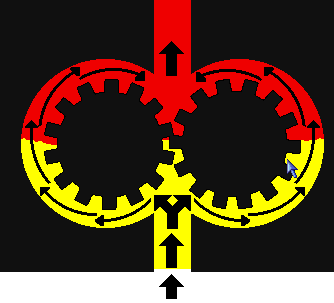
As the liquid comes from the reservoir, it is pushed between the gear teeth. The oil is moved around to the other side by the action of the drive gear itself and sent through the pressure line. What makes the oil squeeze in between the gear teeth? gravity and the pressure head. To prevent leakage of oil from the high to the low pressure side from occurring, you can make the gears fit better.
You might want to increase the pressure used to move the fluid along. However, the higher the pressure, the higher the friction loading on the teeth. Friction will develop heat which will expand the gears and cause the pump to seize (parts will weld together and gears will stop rotating). In order to stop this, you can have the pump case, the gears, and the bearings made out of different materials, (e.g., steel gears [1-1/2 inch thick], bronze bearings, aluminum casing). Normally, the gear speed is higher than the engine speed (normally 1.4 times the engine speed).
Oil can leak over and under the gears. To prevent leakage, you can press the bearings up against the gears. This decreases seepage but this decreases the mechanical efficiency when friction increases. Even though oil acts as lubricant, seizing can occur when oil is drained from the hydraulic system.
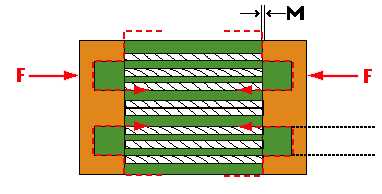
The inlet side of the gear pump
As mentioned previously, we can push the bearings (increasing the force, F) up against the gears to decrease leakage (decreasing the spacing, M). As F increases, M decreases, thus, the gears and bushing increase in friction and mechanical efficiency decreases. When you increase the pressure on the inlet side of the pump, leakage will increase around the gears. To reduce the leakage, you must push the bearings and gears closer (increasing F), causing an increase in friction. That is why inlet pressures over 1500 lb/sq in, are not used.
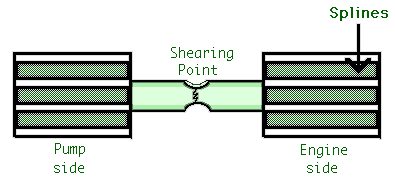
Gear pumps are built using a shear shaft principle. That is, if the pump fails, the shear shaft breaks and this allows each of the gears to rotate in its own part of the system (pump side or engine side) and nothing else will happen to the system. This phenomenon is similar to a fuse in an electrical system. When the electrical system overloads, the fuse breaks, causing the circuit to break without damaging the rest of the electrical circuit.
Principle of the Reciprocating Piston Pump
These kind of pumps attain volumetric efficiencies of up to 98% and they can maintain pressures from 1500 to 6000 psi. They can achieve overall efficiencies of up to 92% and can move fluid volumes up to 35 gallons per minute.
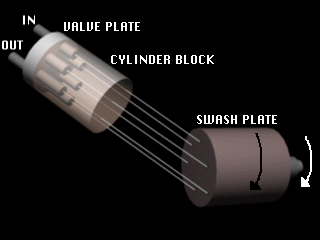
As the cylinder block rotates, space between the block and the pistons increase,
letting in more oil. As the block rotates from bottom dead center, the reverse occurs and
the pistons push oil out through the outlet. When the pistons move down, the suction
caused by the vacuum from the space, created by the movement of the piston, pulls in oil.
Changing the angle between the swash plate and the cylinder block gives a longer pumping
action and causes more fluid to be pulled in. As the cylinder block rotates, the piston
cylinder openings over the inlet and the outlet vary. When cylinders 4-6 take in hydraulic
fluid and act as the inlet to the pump, then cylinders 1-3 push the hydraulic fluid out
and act as outlet to the pump.
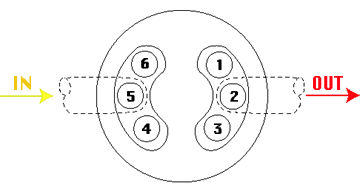
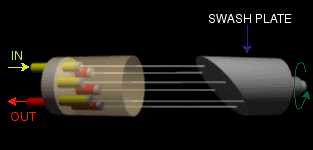
As the shaft and swash plate rotate, the piston will suck oil into the cylinder block and as the shaft and swash plate keep on rotating, the piston pushes oil out through the outlet. Pumps can be made to move more or less oil volume. The following formulae may be used to determine the volumetric output of a piston pump, the pump horsepower, the pump's volumetric efficiency and overall efficiency.
![]()
![]()
![]()
![]()
![]()
Here the number .000583 is a conversion factor from lb-ft/s to horsepower (HP)
Send all comments to ![]() aeromaster@eng.fiu.edu
aeromaster@eng.fiu.edu
© 1995-98 ALLSTAR Network. All rights reserved worldwide.
Updated: February 23, 1999